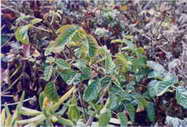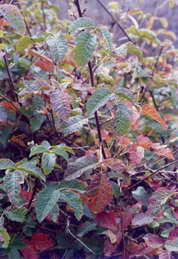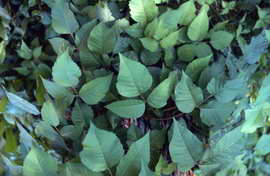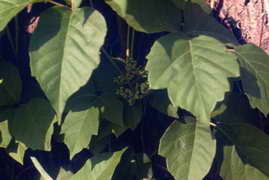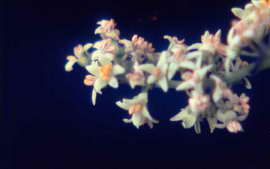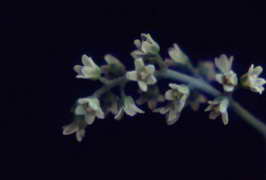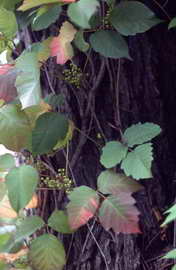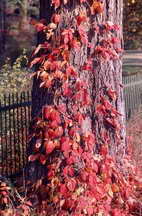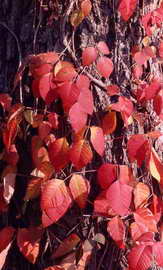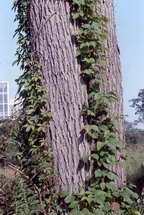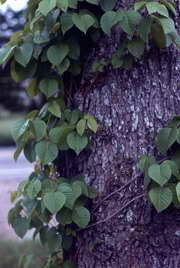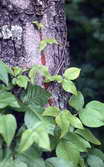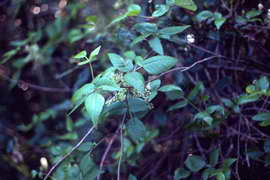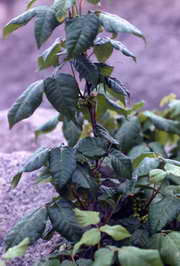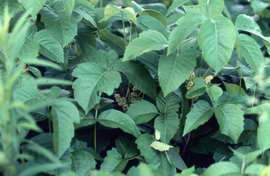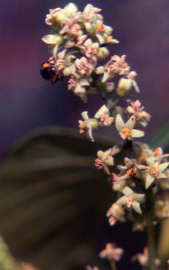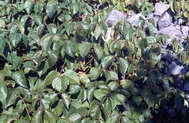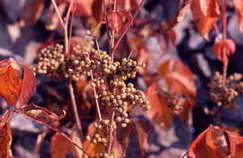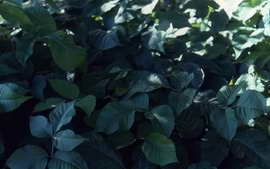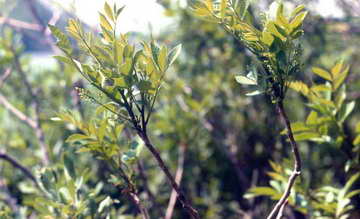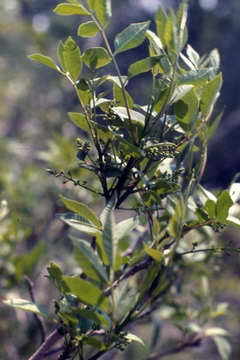Western poison-oak, poison-ivy and poison sumac. (Anacardiaceae-family)
Recent DNA evidence seems to support the transfer of a number of poisonous plants from the genus Rhus to the genus Toxicodendron. This has resulted in scientific name changes for three native plants that are, in our area, one of the most frequent causes of an irritating dermatitis to humans. Fortunately, the common names of these plants remain unchanged. Since these names have been more stable than the scientific names, I have opted to use the common names, western poison-oak, poison-ivy, and poison sumac, in most parts of this treatment.
When the epidermis of roots, stems, leaves or fruit of western poison-oak, poison-ivy, or poison sumac is ruptured, an oil, called urushiol, is released. If this oil comes in contact with the skin of humans, it can produce an irritating dermatitis. The first symptom of poisoning is a severe itching of the skin. This is followed by a blistering of the skin, and in severe cases, the development of oozing sores. The rash is spread by the urushiol oil, not as the result of contamination from the sores. The urushiol oil is technically not a poisonous substance, but is a potent allergen. The rash is called an urushiol-induced dermatitis. The oil can be deposited on a persons skin through direct contact with the plants, or via contaminated clothing, tools, or domestic animals. The urushiol oil can remain potent for an extended period, especially under dry conditions. Burning the poisonous plants can have serious consequences. Inhalation of plant fragments in smoke can produce a painful rash on the lining of lungs, and in some cases has resulted in deaths. Cattle, horses, sheep, hogs, goats, birds, and many other animals are apparently immune to the urushiol oil. Contact with the oil is most frequent in the spring and summer when tender leaves are bruised easily. Since the oil must penetrate cells below the skin layer for a dermatitis reaction to occur, the most severe symptoms are produced in areas that have a thin layer of skin. In general, young children and people with a very light skin color seem to be most sensitive. Most people develop the dermatitis 24 to 48 hours after contact with the oil. Healing time varies from a few days to several weeks, and healed sites often remain supersensitive to any further contact with the oil for a considerable time.
Western poison-oak, sumac de l’Ouest, Toxicodendron diversilobum (Torr. & A.Gray) Greene [=Rhus diversiloba Torr. & A.Gray] Western poison-oak is found along the Pacific Coast from southwestern British Columbia in Canada to the Baja California peninsula in the United States. It is most common in shady and moist locations, but can grow equally as well in full sunlight. It can be a woody shrub, a trailing vine, or a vine climbing many feet up trees, posts, and other rough surfaces. The three leaflets of Western poison-oak have scalloped, toothed or lobed edges, generally resembling the leaves of a true oak. The leaflets of western poison-oak have rounded tips, not the pointed tips of poison-ivy leaflets (see below for photos of western poison-oak and of poison-ivy).
Poison-ivy, herbe à puce, Toxicodendron radicans (L.) Kuntze [=Rhus radicans L.] Poison-ivy is a woody perennial, spreading by seeds and above ground woody rhizomes. It can be a low spreading vine, a climbing vine or a low woody shrub. It has alternate leaves made up of three, usually shiny, leaflets. The middle leaflet has a stalk that is much longer than the stalks of the two lateral leaflets. Flowers are clustered, small, whitish-green, with male and female flowers on separate plants. Fruits are clustered, globose, green to yellow, waxy, small in diameter, and 1-seeded. Three subspecies (or varieties) of poison-ivy are recognized by taxonomists. Although their morphology may intergrade slightly in some areas, they can usually be distinguished by the following characteristics [see below for photos of the three subspecies (or varieties) of poison-ivy].
Central poison-ivy, herbe à puce grimpante, Toxicodendron radicans subsp. negundo (Greene) Gillis [=Rhus radicans var. negundo (Gillis) G.A.Mulligan] Central poison-ivy can take the form of a shrub, a trailing vine, or a vine with aerial roots. It can climb rough surfaces to considerable heights. The pedicels typically have a long, spreading pubescence. The abaxial (lower) surfaces of leaflets typically have a long spreading pubescence, and lack tufts of hairs on the midribs. The vertical stems usually have more than five leaves, and the margins of most of the leaflets are toothed.
Eastern poison-ivy, herbe à puce grimpante, Toxicodendron radicans subsp. radicans (=Rhus radicans var. radicans) Eastern poison-ivy can also be a shrub, a trailing vine or, more commonly, a vine with aerial roots. It can also climb rough surfaces to considerable heights. The pedicels have a short, appressed, ascending puberulence. The abaxial surfaces of leaflets have tufts of hairs towards the bases of the midribs, and ascending hairs along the lateral veins. The vertical stems usually have more than five leaves, and the margins of most of the leaflets are entire.
Rydberg’s poison-ivy, herbe à puce de Rydberg, Toxicodendron radicans subsp. rydbergii (Small ex Rydb.) Á.Löve & D.Löve [=Rhus radicans var. rydbergii (Small ex Rydb.) Rehd. Rydberg’s poison-ivy is a trailing vine or subshrub. It always lacks aerial roots, and it never climbs rough surfaces. The pedicels are glabrous or have a short, appressed, ascending puberulence. The abaxial surfaces of leaflets have spreading hairs along the lateral veins, and lack tufts of hairs on the midribs. The vertical stems usually have fewer than five leaves, and the margins of most of the leaflets are toothed.
Three plants often mistaken for poison-ivy are; hog-peanut, Virginia creeper, and seedlings of Manitoba maple. Poison-ivy has woody stems, some climbing (not twining around) rough surfaces to considerable heights; stems with alternate leaves, each leaf with three leaflets; cream to yellow flowers; fruits that are globose, waxy, and of a green to yellow color. Hog-peanut also has three leaflets but the stems are twining and are not woody; flowers are pea-like and white to lilac in color; the fruits are also somewhat pea-like and are flattish (see photos of hog-peanut under Leguminosae-pea family). Virginia creeper leaves have five leaflets and the plant has globose fruits that are bluish in color (see below for photos of Virginia creeper growing with eastern poison-ivy and central poison-ivy). Seedlings of Manitoba maple have leaves with three leaflets, but the leaves are opposite each other on the stem; rather than alternating, as is the case with poison-ivy. Click here for a photo of a Manitoba maple seedling.
Poison sumac, sumac à vernis, Toxicodendron vernix (L.) Kuntze [= Rhus vernix L.] Poison sumac is a woody shrub or small tree growing to 7 meters (20ft.) tall. It has eight to twelve leaflets arranged in pairs, and an additional single leaflet at the end of the midrib. The small yellowish green flowers, borne in clusters, mature into whitish-green fruits that hang in loose clusters. Poison sumac also has its male and female flowers on separate plants. Poison sumac grows in wet flooded soils, often in swamps and peat bogs, in southeastern Canada and the eastern United States. Poison sumac is said to be more toxic than either poison-oak or poison-ivy (see below for photos of poison sumac).
Click on a photo to view an enlarged image.
| Number of Visitors: |
|
|


